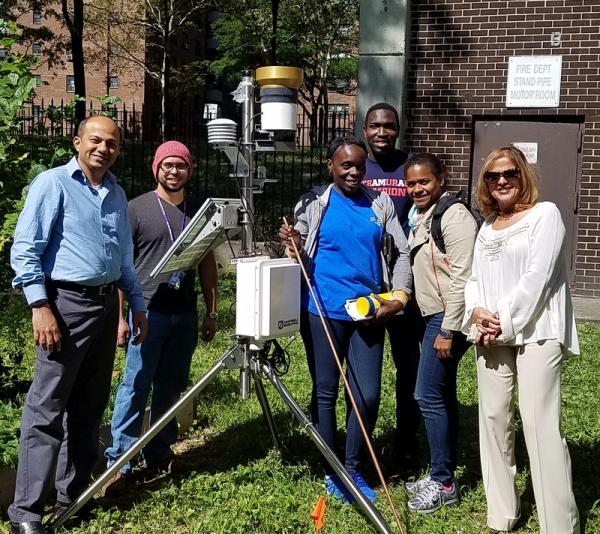
City College’s NOAA CESSRST mini weather station at the Polo Grounds Towers in Harlem. Left is NOAA CESSRST research scientist Tarendra Lakhankar with students and residents.
Dotted around four of New York’s five boroughs are 19 autonomous mini-meteorological stations established by The City College of New York-based NOAA Center for Earth System Sciences and Remote Sensing Technologies (NOAA CESSRST) and CUNY CREST Institute. This is part of CCNY’s singular response to the rising seas and extreme weather conditions in the city caused by climate change.
Dubbed the NY-uHMT (New York Urban Hydrometeorological Testbed) project, it is a one of a kind high-density hydro-meteorological weather network, according to the New York City Mayor’s Office of Recovery and Resiliency, a partner in the venture.
Sites include: JHS High School (Brooklyn), Queens Botanical Garden, Brooklyn Public Library - Brownsville Branch, the Polo Grounds Towers in Harlem and the Dyckman Houses. The last two are NYCHA properties.
NY-uHMT is designed to monitor basic meteorological and hydrological variables to assess the variability in the city’s microclimates and their response to extreme events.
The overarching research objectives of NY-uHMT are:
• To develop integrated high-resolution mapping of ground and atmospheric conditions, focusing on the lower atmosphere, to detect and forecast severe wind, tornado, hail, ice, and flash flood hazards;
• To improve the accuracy and lead time of measuring and accessing the precipitation and providing flash flood forecasts and warnings in the New York City region;
• To create impacts-based, urban-scale flash flood and hazard warnings and forecasts for a range of public and private decision-makers that result in measureable benefit for public safety and the economy;
• To develop collaborative models for federal/municipal/private partnerships for education outreach to NYC schools with on-going interdisciplinary weather system research at NOAA CESSRST and CUNY-CREST Institute.
In addition, data produced from the NY-uHMT stations will be available to the general public, agencies and researchers through open access servers located at center website (click here). For any additional information about data and site locations, please contact Tarendra Lakhankar.
CCNY’s other partners in project include the National Environmental Satellite, Data, and Information Service and USDA-ARS Hydrology and Remote Sensing Laboratory, both based in Maryland; and the New York City Housing Authority (NYCHA).
About The City College of New York
Since 1847, The City College of New York has provided a high quality and affordable education to generations of New Yorkers in a wide variety of disciplines. CCNY embraces its role at the forefront of social change. It is ranked #1 by the Harvard-based Opportunity Insights out of 369 selective public colleges in the United States on the overall mobility index. This measure reflects both access and outcomes, representing the likelihood that a student at CCNY can move up two or more income quintiles In addition, the Center for World University Rankings places CCNY in the top 1.2% of universities worldwide in terms of academic excellence. More than 16,000 students pursue undergraduate and graduate degrees in eight professional schools and divisions, driven by significant funded research, creativity and scholarship. CCNY is as diverse, dynamic and visionary as New York City itself. View CCNY Media Kit.